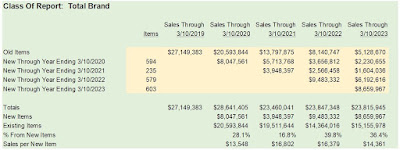I've explained this previously, and the statisticians in the studio audience are going to belly-ache about what I'm about to explain, but here's what I do ... I'm transparent about my methodologies.
Step 1: Select twelve-month buyers as of 12 months ago.
Step 2: Calculate historical spend in 0-12, 13-24, 25-36, and 37-48 month buckets.
Step 3: Calculate future spend in the next twelve-months.
Step 4: Regress the four variables in Step 2 against the dependent variable in Step 3.
Step 5: Evaluate the coefficients for the 0-12 month spend variable, 13-24 month spend variable, 25-36 month spend variable, and the 37-48 month spend variable. Let's pretend that they are as follows ... 0.604 ... 0.369 ... 0.235 ... 0.134. Divide each value by the value of the 0-12 month coefficient (0.604), giving us 1.000, 0.611, 0.389, 0.222.
We now have our weights ... we weight 0-12 month dollars by 100%, we weight 13-24 month dollars by 61%, we weight 25-36 month dollars by 39%, and we weight 37-48 month dollars by 22%.
Step 6: For each category, we calculate weighted dollars spent during the past four years, as of one year ago.
Step 7: For each category, we calculate total dollars spent in the past year.
Step 8: We run a regression for each category ... the independent variables are weighted dollars spent in each category, the dependent variable is amount spent in the past year for a specific category. This way, we learn which categories contribute to future spend within a specific category.
Step 9: We repeat Step 2, shifting our date ranges one year forward.
Step 10: We score each customer for each category for the next year.
Step 11: If desired, results are placed into deciles for each category.
At this point, you have completed Category Target Modeling ... you now have targeting variables for every category. If you wish to send an email campaign to Mens Outerwear customers, you use the Mens Outerwear Category Targeting Model results.
Again - statisticians are gonna grumble about the methodology. Let them come up with their own ... this methodology is simple and effective and proven to work in the real world.
P.S.: Yes, you can use logistic regression here as well with a 1/0 dependent variable. Works well.










